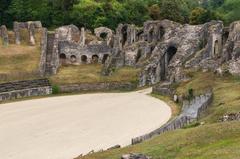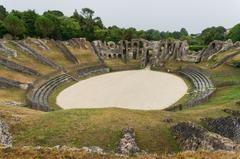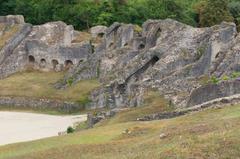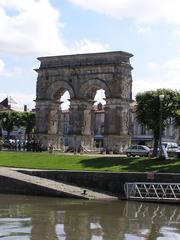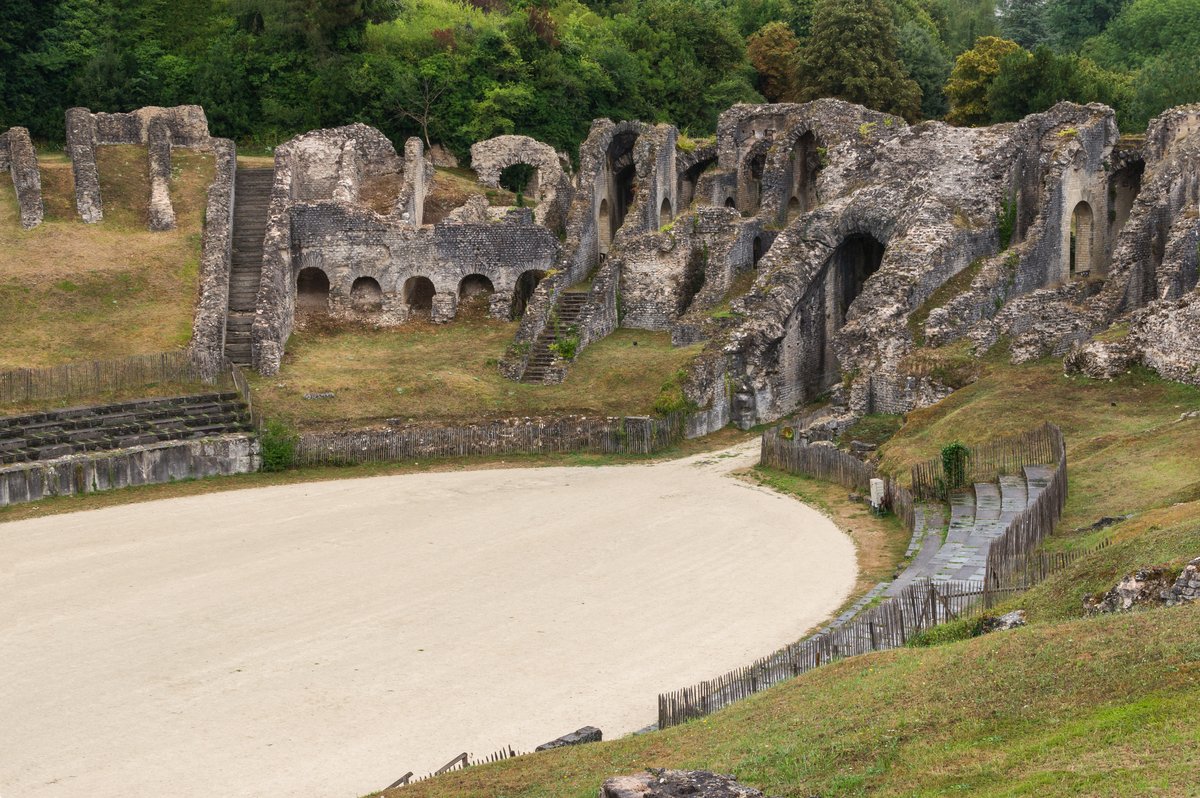
Roman Amphitheatre of Saintes: Visiting Hours, Tickets, and Historical Significance
Date: 15/06/2025
Introduction
The Roman Amphitheatre of Saintes, located in southwestern France, stands as one of the most remarkable and well-preserved examples of Gallo-Roman antiquity. Constructed in the 1st century AD under Emperors Tiberius and Claudius, this monumental structure was ingeniously integrated into the natural contours of the Vallon des Arènes. Its strategic placement not only enhanced structural stability and acoustics but also showcased the Romans’ architectural innovation. Originally seating between 12,000 and 18,000 spectators, the amphitheatre underscored Saintes’ (then Mediolanum Santonum) prominence as a regional capital in Roman Aquitaine. Today, visitors can explore a site that once hosted gladiatorial games, wild beast hunts, and public spectacles central to Roman civic life and identity (The Crazy Tourist, The Good Life France, Spotting History, Saintes Tourisme).
This guide provides a detailed overview of the amphitheatre’s history, architectural significance, visiting hours, ticket information, and practical tips to maximize your visit. For the latest updates and detailed visitor information, consult the official Saintes tourism website or the Audiala app.
Contents
- Introduction
- Historical Background and Cultural Importance
- Architecture and Construction Techniques
- Tickets, Visiting Hours, and Accessibility
- Visitor Experience and Practical Tips
- Frequently Asked Questions (FAQ)
- Nearby Attractions
- Events and Activities
- Conclusion and Recommendations
- References
Historical Background and Cultural Importance
Constructed between 40 and 50 AD, the Amphitheatre of Saintes was a central venue for public entertainment in Roman Aquitaine. Its events ranged from gladiatorial contests and animal hunts (venationes) to public executions—spectacles that both entertained and reinforced the social order. The amphitheatre was also a space for civic rituals and gatherings, serving as a tangible symbol of Roman authority and cultural integration in the provinces (The Good Life France).
Archaeological discoveries near the site, including graves with skeletons still shackled, highlight the darker realities of Roman society and the roles of slaves and criminals in these deadly games (Daily Mail). Subterranean tunnels—accessible to modern visitors—once served as passageways for gladiators and animals, evoking the tension and drama that defined the ancient arena.
Architecture and Construction Techniques
Site Integration and Layout
The amphitheatre’s elliptical structure (measuring approximately 126 by 102 meters) was ingeniously set into a natural valley, combining earthworks with stone masonry. This design maximized the natural slope for seating (cavea) and contributed to the stability of the structure (Spotting History).
Key Features
- Arena and Podium: The central arena, with its sand-covered floor, was surrounded by a high podium wall for spectator safety.
- Seating Tiers (Cavea): Tiered stone benches reflected the strict Roman social hierarchy, with the best seats reserved for dignitaries.
- Entrances and Vomitoria: Multiple entrances allowed for efficient crowd movement, with original arches still visible today.
- Vaulted Substructures: Roman concrete vaults supported the seating and provided space for animals and performers beneath the arena (History and Archaeology Online).
Though much of the original decorative stonework is lost, traces suggest sculpted elements and painted surfaces once adorned the amphitheatre, further enhancing its grandeur.
Preservation
Despite centuries of quarrying and weathering, significant portions of the amphitheatre remain, particularly the eastern seating tiers. Restoration efforts in the 19th and 20th centuries stabilized the structure, making it accessible to visitors and preserving its historical integrity (Saintes Tourisme).
Tickets, Visiting Hours, and Accessibility
- Opening Hours: The amphitheatre is generally open daily from 10:00 AM to 6:00 PM (April–October), and 10:00 AM to 5:00 PM (November–March). Last admission is 30 minutes before closing. Check the official tourism website for seasonal variations and holiday hours.
- Tickets: Entry is typically free, though guided tours and special events may require a ticket (€5–€10). Discounts are available for students, seniors, and children; EU residents under 26 often enter free (Saintes Tourisme).
- Guided Tours: Offered mainly in summer and during heritage events. Advance booking via the tourism office or Audiala app is recommended.
- Accessibility: Most areas are accessible via gently sloping paths, though some stone steps and tunnels may be challenging for visitors with limited mobility. The site is family- and pet-friendly (leashed dogs permitted).
Visitor Experience and Practical Tips
- Best Times to Visit: Spring and early autumn provide pleasant weather and fewer crowds. Summer features extended hours and cultural events.
- Footwear: Wear sturdy, comfortable shoes due to uneven terrain and original stone steps.
- Facilities: Minimal on-site amenities; restrooms, cafés, and parking are available nearby.
- Interpretive Panels: Bilingual signage offers historical and architectural context throughout the site.
- Photography: Early morning and late afternoon light is ideal for capturing the amphitheatre’s dramatic stonework.
Frequently Asked Questions (FAQ)
Q: What are the current opening hours?
A: Generally, 10:00 AM–6:00 PM (April–October), 10:00 AM–5:00 PM (November–March). Check the official website for updates.
Q: Is there an entrance fee?
A: General admission is free. Guided tours and some events may require a small fee.
Q: Are guided tours available?
A: Yes, mainly in summer and on special occasions. Book via the tourism office or Audiala app.
Q: Is the site accessible for wheelchairs?
A: Most areas are accessible, though some steps and tunnels may not be.
Q: Can I bring my dog?
A: Leashed dogs are welcome.
Nearby Attractions
Saintes is rich in Roman and medieval heritage. Notable sites within walking distance include:
- Arch of Germanicus: A triumphal arch dating to 18 AD.
- Abbaye aux Dames: A former Benedictine abbey with a unique musical heritage.
- Saint-Eutrope Basilica: A UNESCO-listed Romanesque church.
- Roman Baths and Archaeological Museum: Offering further insights into the city’s ancient past (Guide Charente Maritime).
Consider combining your amphitheatre visit with a stroll along the Charente River or a guided walking tour for a comprehensive experience.
Events and Activities
The amphitheatre is a vibrant cultural venue during summer, hosting concerts, theatrical performances, and historical reenactments. The annual European Heritage Days feature special tours, Roman martial arts demonstrations, and family-friendly workshops (Saintes Tourisme).
Conclusion and Recommendations
The Roman Amphitheatre of Saintes is a testament to Roman engineering, cultural vitality, and the enduring legacy of ancient Aquitaine. Its well-preserved architecture and immersive atmosphere offer a direct connection to the spectacles and social dynamics of Roman provincial life. Today, the site not only preserves history but also fosters community through cultural events and educational programs.
For a rewarding visit, plan ahead using the official Saintes tourism website and the Audiala app for up-to-date information, interactive maps, and audio guides. Exploring the amphitheatre alongside the city’s other Roman monuments promises a comprehensive and memorable journey through France’s ancient heritage.
References
- The Crazy Tourist – 15 Best Things to Do in Saintes
- History and Archaeology Online – The History of Roman Amphitheatres
- Audiala – Saintes Tourism
- Guide Charente Maritime – Top 10 Things to Do in Saintes
- The Good Life France – What to See and Do in Saintes Charente Maritime
- Daily Mail – Skeletons Shackled Unearthed in Roman Graves
- Spotting History – Roman Amphitheatre of Saintes
- History Hit – Ancient Amphitheatres in France
- Saintes Tourisme – Amphitheatre Gallo-Romain
For further reading and virtual tours, visit the official Saintes tourism website.
